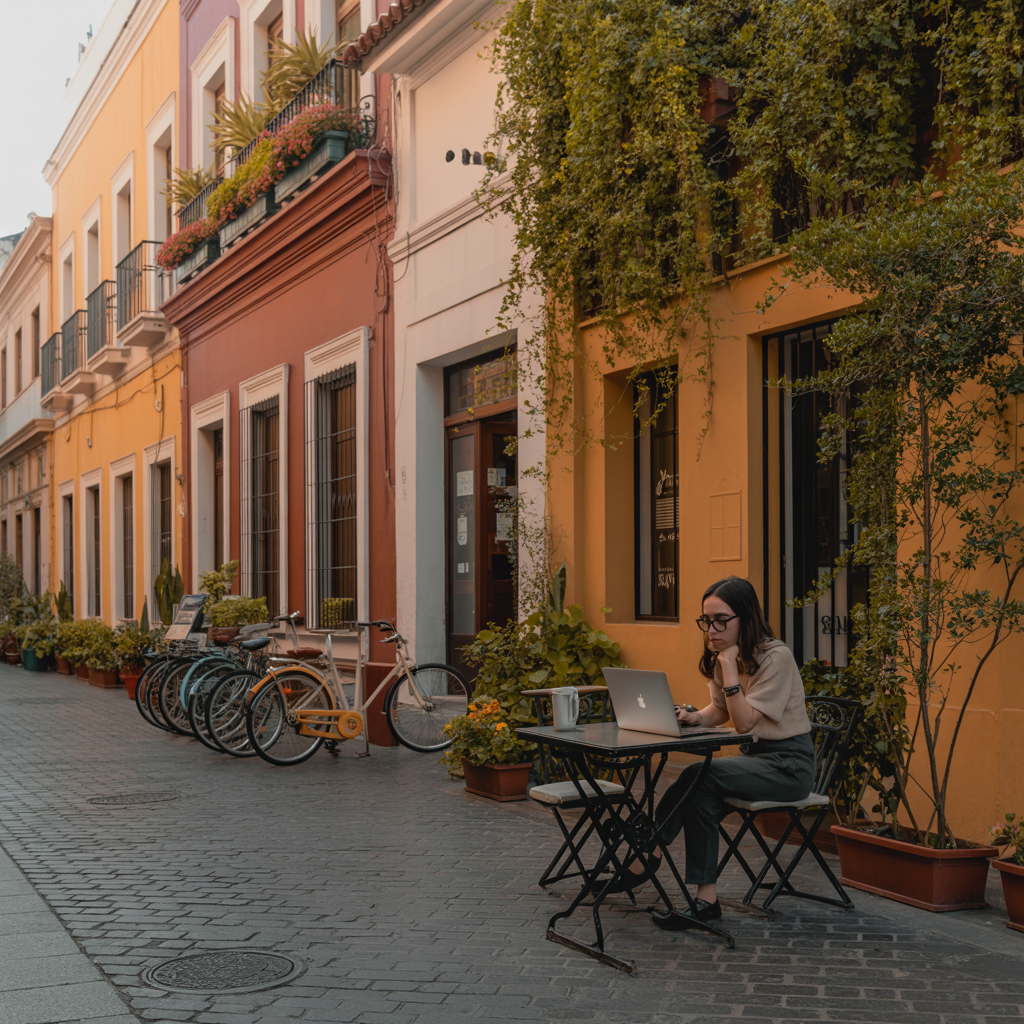Urban Zen: The Most Peaceful Neighborhoods in Big Cities for Remote Workers
The espresso machine hisses gently in the corner café, morning light filters through century-old windows, and the distant hum of city life feels oddly soothing rather than overwhelming. This isn’t a contradiction—it’s urban zen, and it might just be the perfect antidote to our always-on world.
While Instagram feeds overflow with pristine beaches and mountain retreats, there’s something magical about finding tranquility in the heart of a bustling metropolis. These aren’t just neighborhoods; they’re sanctuaries where creativity flourishes, where the energy of city life meets the rhythm of a slower pace, and where remote workers discover that productivity and peace can coexist beautifully.
From the cobblestone streets of Mexico City’s artistic quarter to Rome’s riverside bohemian enclave and Tokyo’s indie haven, these urban oases offer something increasingly rare: authentic local culture without the tourist circus, reliable infrastructure without the corporate sterility, and community without the isolation.
Why Urban Zen Matters More Than Ever
The traditional digital nomad narrative often focuses on escaping cities entirely, but many of us crave a different kind of balance. We want the stimulation of urban culture, the reliability of city infrastructure, and the serendipity of diverse communities—just without the sensory assault that comes with living in Times Square or Oxford Circus.
Urban zen neighborhoods deliver exactly this combination:
- Dependable connectivity for when deadlines loom
- Cafés with soul where regulars know your coffee order
- Cultural richness that fuels creativity between work sessions
- Community spaces that feel genuine rather than manufactured
- Walkable streets that invite exploration without exhaustion
These areas work particularly well for travelers who prefer depth over breadth—staying weeks or months rather than days, building routines rather than just collecting experiences.
🌿 Coyoacán, Mexico City: Where Art Lives On
Step into Coyoacán and you’ll understand why Frida Kahlo chose to call it home. This neighborhood doesn’t just house art—it breathes it. The morning air carries the scent of fresh tortillas and blooming jacaranda trees, while murals peek around corners like secrets waiting to be discovered.
Unlike the frenetic pace of central Mexico City, Coyoacán operates on artist time. Conversations linger over café tables, street musicians perform for the love of it rather than tips, and even the weekend markets feel more like community gatherings than commercial ventures.
Making Coyoacán Work on Any Budget
Where to Stay: Skip the generic hotels and embrace local living. Airbnb rooms in colonial houses near Parque Frida Kahlo offer the perfect blend of character and connectivity. Many hosts are artists themselves and become unexpected sources of local insight.
Eating Well for Less: The covered market on Avenida Independencia serves some of the city’s best casual food at neighborhood prices. Try the pozole at the corner stall, or grab fresh fruit agua frescas that cost less than bottled water. For sit-down meals, La Pitahaya Vegana proves that plant-based Mexican cuisine can be both affordable and soul-satisfying.
Getting Around: Coyoacán rewards walkers. Most work cafés, cultural sites, and daily necessities lie within a comfortable 15-minute stroll. For longer distances, the Ecobici bike-share system connects seamlessly to the metro.
Don’t Miss Moments
- Early morning at Viveros de Coyoacán: This tree nursery doubles as a peaceful park where locals jog, practice tai chi, and walk dogs. It’s Mexico City’s best-kept green secret.
- Sunday markets in Plaza Hidalgo: Street food, handmade crafts, and impromptu performances create a weekly celebration of local culture.
- Casa Azul after 3 PM: Tourist crowds thin out, making Frida’s former home a more contemplative experience.
Safety note: Coyoacán ranks among Mexico City’s safest neighborhoods, but like anywhere, stick to well-lit streets after dark and trust your instincts.
🍷 Trastevere, Rome: Timeless Charm Meets Modern Life
Cross the Tiber River and enter a Rome that feels both ancient and refreshingly contemporary. Trastevere’s narrow medieval streets echo with the sounds of daily life: children playing football against church walls, neighbors calling to each other from flower-filled balconies, and the rhythmic clatter of evening aperitivo preparations.
This neighborhood has mastered the art of being discovered without being ruined. Yes, visitors come for the romantic atmosphere, but locals still outnumber tourists, creating an authentic energy that’s impossible to manufacture.
Stretching Your Euro in Trastevere
Smart Accommodation: Medium-term rentals (1-3 months) through Spotahome or HousingAnywhere offer the best value. Look for apartments on residential streets rather than main piazzas—you’ll save money and gain authenticity. The shoulder seasons of spring and fall bring perfect weather and reduced prices.
Eating Like a Roman: Tourist-trap restaurants cluster around Piazza Santa Maria, but venture two blocks in any direction for family-run trattorias where pasta costs half the price and tastes twice as good. Da Enzo al 29 serves legitimately traditional Roman cuisine, while Trapizzino reinvents street food with gourmet ingredients.
Sustainable Exploring: The neighborhood’s compact size makes everything walkable, but morning trips to Mercato di San Cosimato connect you with local producers and seasonal ingredients. Shopping here supports Roman families while ensuring your home cooking uses the freshest possible ingredients.
Beyond the Guidebooks
- Gianicolo Hill at sunset: A 10-minute climb rewards you with panoramic views and a genuine Roman tradition—locals gather here nightly to watch the city glow golden.
- Via della Lungaretta browsing: Vintage shops, artisan studios, and tiny bookstores line this quieter street, perfect for afternoon discoveries.
- Evening aperitivo culture: Romans treat this pre-dinner ritual seriously. Order a spritz, receive complimentary snacks, and observe one of Italy’s most cherished social customs.

🎧 Shimokitazawa, Tokyo: Where Indie Culture Thrives
In a city famous for its intensity, Shimokitazawa offers something precious: permission to slow down. This neighborhood operates on a different frequency than the rest of Tokyo—more vinyl records than digital billboards, more independent coffee shops than chain stores, more conversations than commuter silence.
Known locally as “Shimokita,” this area attracts Tokyo’s creative class: musicians, artists, vintage enthusiasts, and anyone seeking an alternative to corporate culture. The result is a neighborhood that feels simultaneously very Japanese and refreshingly international.
Experiencing Shimokita Thoughtfully
Where to Rest: Traditional accommodations here are limited, but nearby Shibuya offers capsule hotels like The Millennials, perfect for testing whether Tokyo life suits you. For longer stays, OYO Life Japan provides furnished rooms designed for young professionals and travelers.
Navigating the City: A Suica card makes Tokyo’s complex transit system simple, and Shimokitazawa’s central location connects easily to everywhere else. But some of the neighborhood’s best discoveries happen on foot—allow time for wandering.
Fueling Creativity: Ramen at Yumeya satisfies both hunger and curiosity (their chashu pork is legendary), while Bear Pond Espresso serves coffee so carefully crafted that each cup feels like a meditation. For healthy options, Café Stay Happy proves that vegan food in Japan can be both delicious and affordable.
The Creative Pulse
- Co-working at BUKATSUDO: This renovated public bath now houses artists, designers, and remote workers. The communal atmosphere sparks unexpected collaborations.
- Live music venues: Shelter and Three host intimate concerts where you might discover your next favorite band or witness established artists in surprisingly personal settings.
- Village Vanguard bookstore: Equal parts bookshop, curiosity museum, and cultural commentary. Even non-Japanese readers find treasures among the eclectic selection.
Cultural note: Japan’s social customs enhance rather than restrict the experience once you understand them. Quiet train rides become opportunities for reflection, and shoe removal in traditional spaces adds mindfulness to daily routines.
Cultivating Your Own Urban Zen
The secret to finding peace in any big city isn’t about luck—it’s about intention. These practices work whether you’re exploring established zen neighborhoods or creating your own sanctuary in unexpected places:
Establish Anchors: Choose a regular café for morning work sessions, a specific route for evening walks, a weekly market visit. Routines transform foreign places into temporary homes and create structure in otherwise fluid travel lifestyles.
Seek Green Spaces: Every major city contains nature, often in surprising forms. Tokyo’s tiny shrine gardens, Rome’s villa parks, and Mexico City’s hidden courtyards all offer moments of restoration. Make finding and visiting these spaces a priority, not an afterthought.
Embrace Local Rhythms: Each neighborhood operates on its own schedule. Romans take long lunches, Mexicans extend coffee conversations, and Japanese commuters respect collective quiet. Observing and adapting to these rhythms reduces stress and increases authentic cultural connection.
Choose Location Over Luxury: A simple room on a residential street often provides more genuine local experience than a fancy hotel near tourist attractions—at a fraction of the cost. Neighborhood life unfolds naturally when you’re part of the community rather than visiting it.
Document Your Journey: Whether through journaling, photography, or voice memos, recording how different environments affect your creativity and well-being helps refine future travel decisions. What energizes you in Tokyo might exhaust you in Rome, and that’s valuable self-knowledge.
The Quiet Revolution
Urban zen isn’t about escaping cities—it’s about engaging with them more mindfully. It’s choosing depth over speed, quality over quantity, and community over isolation. For remote workers and thoughtful travelers, these peaceful pockets within global cities offer something increasingly precious: the opportunity to live locally while thinking globally.
Whether you’re editing presentations while church bells chime in Trastevere, taking client calls as Mexico City’s morning light dances through colonial windows, or brainstorming projects to the gentle hum of Tokyo’s indie heartbeat, remember this: peace doesn’t require leaving civilization behind. Sometimes it just requires finding the right neighborhood.
The next time wanderlust strikes, consider this alternative narrative. Instead of seeking the most remote beach or highest mountain peak, look for the quiet street in the bustling city, the local café in the international metropolis, the community garden in the concrete jungle. Urban zen awaits, and it might just change how you think about both travel and work forever.
Related Post: The Bleisure Blueprint: How to Blend Business Trips with Unforgettable Adventures













